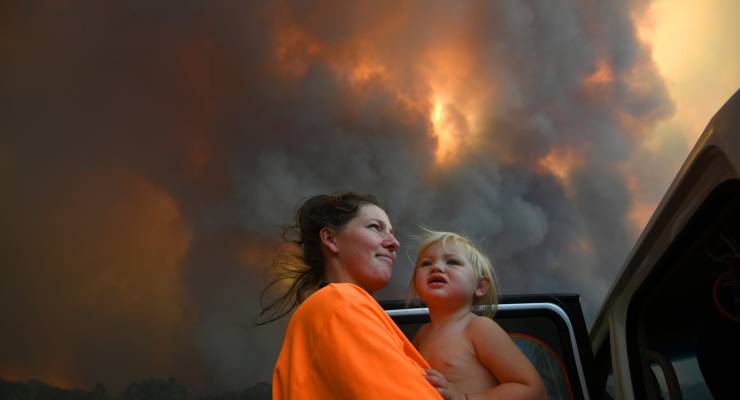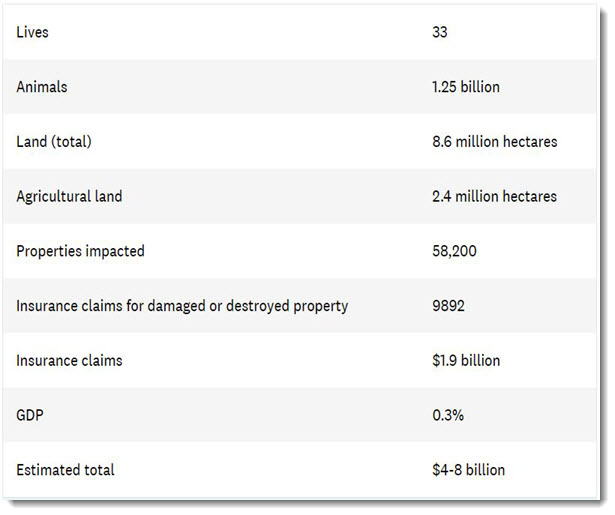
The economic cost of the bushfires is bigger than first thought, according to revised figures provided to Crikey.
Economists now say the bushfires will cost the Australian economy between $4 billion and $8 billion in property, productivity, consumer spending and business losses.
While costs are still being calculated, Crikey takes an early look into what’s been lost.
The losses

How did we get here?
Anecdotally, land razed is anywhere between the size of Belgium and South Korea. For a more scientific approach, Crikey turned to rural tech startup Digital Agricultural Services (DAS).
Using satellite imagery, the CSIRO-funded company calculated 8.6 million hectares of land has been impacted by the bushfires — 2.4 million hectares of this is agricultural land, with an estimated 58,200 buildings impacted.
Of those 58,200 buildings, insurance claims have been made for less than 10,000. A spokesperson for the Insurance Council of Australia told Crikey 23,300 claims have been lodged so far, totalling $1.9 billion — they say about 75% of Australians are insured.
The vast majority of claims are for domestic losses, including 9892 claims for home building, 5837 for home contents, and 1537 for domestic motor vehicles.
Given a recent survey found nearly 80% of Australians were affected in some way by the bushfires, with 14.4% directly exposed through property damage or evacuations, it’s no surprise that figure is so high.
There are other costs, too: Telstra says bushfires have cost the company around $50 million in damage to infrastructure, and the Australian Tourism Export Council claims the sector will lose $4.5 billion (a figure much larger than some economic models predict).
Economists claim the country’s GDP will take a 0.3% hit as the country splurges on recovery (though given things like military evacuations have a positive effect on GDP, it’s not the best tool to use).
What’s our best guess?
So how should we tally all these costs up? Economists at SGS Economics and Planning had a stab at it, estimating the fires will cost the economy between $4 billion and $8 billion.
Terry Rawnsley, a partner at the company, told Crikey their methodology combines insurable losses with economic ones.
“$100 of insurable losses might be $300-500 in economic losses … your business burnt down so you’re not purchasing things, you lost a tractor which means you can’t farm a crop or milk your remaining cows,” Rawnsley said.
In the retail and tourism sector, there are often zero insurable losses, but the economy still takes a huge hit. Sydney’s retail spending, for instance, plummeted when locals donned face masks. It turns out not many felt like shopping when they could hardly breathe.
“People were not going to work, they were being evacuated [with] fire alarms, they weren’t going out for drinks after work … Looking at retail trade numbers for December, NSW had an obvious drop in spending,” he said.
The huge variation in the $4-8 billion figure is partly dependent on how quickly we start to rebuild. “We just don’t have enough information to get a more precise number,” Rawnsley said.
When the bushfire season comes to an end, and as people return and make plans to rebuild, we’ll have a better idea of what the total bushfire bill will be.








A bleak outlook indeed.
But I do wish commenters, analysts and other would quitquoting the GDP as a measure.
It measures, effectively, only the movement of money and not the direction of movement.
It has little bearing in reference to the financial wellbeing of the country.
GDP is a measure of activity not intrinsic value so it is nonsensical to say that it will be reduced by disaster – traffic accidents, to economists, are good for the economy.
The recovery itself will be a big boost, not to mention the increased retail turnover when everything from whitegoods to teaspoons are replaced – pity about the trade deficit, virtually all of that being imported … pace BK!
BTW, “…insurance claims have been made for FEWER than 10,000…”
War, to economists, is also good for the economy. Think rebuilding Hamburg after Operation Gomorrah. Shame it doesn’t happen more often, isn’t it?
Workers in outer suburbs and regional cities are bearing the brunt of a slowdown that is cutting their wages, according to figures that reveal the regions where Australians are struggling to get more work. Regional disparities are not merely ignored but are increasing. Asset-, income-, and productivity stripping of the whole of our society by transnational financial and comprador interests based in Sydney and Melbourne CBDs is merely most obvious in the regions.
“Recovery” simply reflects that we believe the fairy tales presented to us about our economy by the media and politicians.
Incidentally, 10,000 claims is a lot of claims. Anyway, more are coming.
National reconstruction and recovery with a bipartisan commission of the brightest and best minds to run for as long as it takes to reinvent the way we must live on and with the land. Oh, just woke up, we’re getting a space station instead.
As long as it’s only certain ‘losses’ (some of which are incalculable) being discussed, the figure may well be in the range quoted. But I don’t see effects on tourism and other service industries, employment and consumption, infrastructure, or even lost economic output, in the list, just for a start; the ‘final’ cost of the bushfires is going to be vastly more ‘immense’ than the upper-end $8m mentioned here, and won’t be known for a long time as the effects of the fires reverberate through the years.
What “recovery”? These disasters would do irreparable damage to some regions. Observe not only that morrison et al show no interest, but also they are working hard to give as little as possible to those in need – even those whose businesses would most benefit! As with Centrelink beneficiaries, the uglies who populate today’s Misgovernments argues it should not be required to pay compensation for the robodebt fraud because social security law makes no mention of a need to exercise “due or reasonable care”.
Forgotten the deterioration of the regions under globalisation and income- and asset-stripping by our foreign-owned governments haven’t we?
Throughout Australia’s regions we see the obvious damage done by our outdated 60s fascination with Big Mining, transmogrified since then as it is by globalisation, by technological change, by the extreme wealth of Big Mining’s looters, and by its – obvious – manipulation to ensure that its wealth goes elsewhere. But its very well-funded media PR efforts and political donations to Labor and the Coalition are relentless and effective, while grossly exaggerating the value of today’s mining industry.